
Today, double doses of Hugh Harman, early Chuck Jones, and a couple of major features, with some added spice from Mickey, Donald and Goofy and Porky Pig, as we continue our storm tracking into mid-1940.
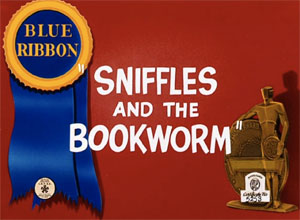 Sniffles and the Bookworm (Warner, Merrie Melodies (Sniffles), 12/2/39 – Charles M. (Chuck) Jones, dir.), receives honorable mention for some brief weather atmospherics that produce a cold, snowy night, forcing the transient Sniffles the Mouse to seek shelter within the nearest hole in a wall he can find. His trail leads him inside an old bookstore. (We’re not quite sure in what land, as signs on the walls inside refer to books being sold at 2 Shillings to tuppence, while another sign advertises the works of Porky Pig!) Sniffles settles down against the cover of a leather-bound volume, his hat encrusted with icicles from the cold outside, and falls fast asleep. Suddenly, a bulge begins to develop in the cover of the book on which Sniffles’ head is resting, and a small green worm with a collar and tie and rectangular spectacles pops through a hole he has chewed in the manuscript to look outside. He spots the stranger sleeping only a hand’s distance from his face, and becomes frightened, disappearing back into the book, but dropping his glasses. Cautiously, he reaches his hand out the hole to retrieve the spectacles, but grabs Sniffles’ tail by mistake, arousing him. The two spy each other face to face, and the worm becomes doubly-frightened, disappearing again, this time with his spectacles. Out a tunnel bored through about a dozen books, the worm pops at the other end of the bookshelf, and scurries for help against the new stranger, to the volume of the story of the Pied Piper. Opening its cover, he arouses a living Piper asleep within, and whispers a description of his encounter with the stranger in the Piper’s ear. However, in pantomime, he gestures to the Piper the dimensions of the stranger, exaggerating them to monstrous size. The Piper begins to march bravely toward the unknown foe, then hesitates and stops, pantomiming to the worm as if to say, “How big?” The worm convinces him the foe is about a third bigger than the Piper is, and the Piper slaps his hand into his face in a sort of Edgar Kennedy-take as if to say “What am I doing?” Thinking better of his own bravado, the Piper knocks on the cover of another book, summoning a larger, Eric the Red-type Viking armed with a club to do the battling for them. They all proceed cautiously back toward the wormhole, not noticing that Sniffles is now wide awske, and curiously following their parade behind them. The Viking shushes those behing him, and the Piper and worm repeat the shush to those in the rear – leading the worm to spot Sniffles again. He hurries the Piper and the Viking around the corner of a stack of books, then indicates in pantomime that that’s the monster. One look, and the Piper and Viking realize that the worm’s tale has been majorly blown out of proportion. The worm continues to gesture with his hands how huge the beast is, but realizes his audience is no longer buying it, causing the distance between his hands to grow smaller, and smaller, and smaller, until the worm finally cowers and slithers meekly away, revealed as a total coward.
Sniffles and the Bookworm (Warner, Merrie Melodies (Sniffles), 12/2/39 – Charles M. (Chuck) Jones, dir.), receives honorable mention for some brief weather atmospherics that produce a cold, snowy night, forcing the transient Sniffles the Mouse to seek shelter within the nearest hole in a wall he can find. His trail leads him inside an old bookstore. (We’re not quite sure in what land, as signs on the walls inside refer to books being sold at 2 Shillings to tuppence, while another sign advertises the works of Porky Pig!) Sniffles settles down against the cover of a leather-bound volume, his hat encrusted with icicles from the cold outside, and falls fast asleep. Suddenly, a bulge begins to develop in the cover of the book on which Sniffles’ head is resting, and a small green worm with a collar and tie and rectangular spectacles pops through a hole he has chewed in the manuscript to look outside. He spots the stranger sleeping only a hand’s distance from his face, and becomes frightened, disappearing back into the book, but dropping his glasses. Cautiously, he reaches his hand out the hole to retrieve the spectacles, but grabs Sniffles’ tail by mistake, arousing him. The two spy each other face to face, and the worm becomes doubly-frightened, disappearing again, this time with his spectacles. Out a tunnel bored through about a dozen books, the worm pops at the other end of the bookshelf, and scurries for help against the new stranger, to the volume of the story of the Pied Piper. Opening its cover, he arouses a living Piper asleep within, and whispers a description of his encounter with the stranger in the Piper’s ear. However, in pantomime, he gestures to the Piper the dimensions of the stranger, exaggerating them to monstrous size. The Piper begins to march bravely toward the unknown foe, then hesitates and stops, pantomiming to the worm as if to say, “How big?” The worm convinces him the foe is about a third bigger than the Piper is, and the Piper slaps his hand into his face in a sort of Edgar Kennedy-take as if to say “What am I doing?” Thinking better of his own bravado, the Piper knocks on the cover of another book, summoning a larger, Eric the Red-type Viking armed with a club to do the battling for them. They all proceed cautiously back toward the wormhole, not noticing that Sniffles is now wide awske, and curiously following their parade behind them. The Viking shushes those behing him, and the Piper and worm repeat the shush to those in the rear – leading the worm to spot Sniffles again. He hurries the Piper and the Viking around the corner of a stack of books, then indicates in pantomime that that’s the monster. One look, and the Piper and Viking realize that the worm’s tale has been majorly blown out of proportion. The worm continues to gesture with his hands how huge the beast is, but realizes his audience is no longer buying it, causing the distance between his hands to grow smaller, and smaller, and smaller, until the worm finally cowers and slithers meekly away, revealed as a total coward.
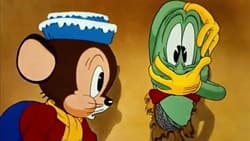 The remainder of the film becomes a jam session, as the Piper produces hs own pipe, and a small clarinet for Sniffles, and the inhabitants of various Mother Goose books perform a spirited medley of “Mutiny in the Nursery”, “Oats Peas Beans and Barley Grow”, ad “Sing a Song of Sixpence.” Even the bookworm is handed a trumpet and joins in. Their playing, however, awakens the Frankenstein monster from the pages of his famous novel, who lumbers forward to seek revenge. Most of the musicians spot the monster quickly and scatter away, leaving only the worm and Sniffles. The monster towers over the worm, who looks up, then literally deflates in a dead faint. Seeing the worm in danger, Sniffles reflexively calls out “STOP”, then equally-reflexively slaps his hand over his mouth in a too-late effort to prevent calling attention to himself. The monster is distracted, and takes off after Sniffles, ignoring the worm. Sniffles leads the monster around a corner, to the end of a bookshelf ending in a steep drop to the floor several shelves below. As the monster rounds the corner, Sniffles hides around the cover of a book teetering near the edge of the shelf, then sticks out his foot to trip the monser (a feat rather-poorly animated, as it does not seem realistic that his small foot could divert the monster’s mass). The monster falls off the shelf to his presumed doom, and Sniffles returns to his resting place to resume slumber against the book cover. Out of the cover appears the worm again, who plants on Sniffles’ cheek a big “thank-you” kiss, then shyly disappears back into the hole, dropping his glasses again, as Sniffles smiles for the iris out.
The remainder of the film becomes a jam session, as the Piper produces hs own pipe, and a small clarinet for Sniffles, and the inhabitants of various Mother Goose books perform a spirited medley of “Mutiny in the Nursery”, “Oats Peas Beans and Barley Grow”, ad “Sing a Song of Sixpence.” Even the bookworm is handed a trumpet and joins in. Their playing, however, awakens the Frankenstein monster from the pages of his famous novel, who lumbers forward to seek revenge. Most of the musicians spot the monster quickly and scatter away, leaving only the worm and Sniffles. The monster towers over the worm, who looks up, then literally deflates in a dead faint. Seeing the worm in danger, Sniffles reflexively calls out “STOP”, then equally-reflexively slaps his hand over his mouth in a too-late effort to prevent calling attention to himself. The monster is distracted, and takes off after Sniffles, ignoring the worm. Sniffles leads the monster around a corner, to the end of a bookshelf ending in a steep drop to the floor several shelves below. As the monster rounds the corner, Sniffles hides around the cover of a book teetering near the edge of the shelf, then sticks out his foot to trip the monser (a feat rather-poorly animated, as it does not seem realistic that his small foot could divert the monster’s mass). The monster falls off the shelf to his presumed doom, and Sniffles returns to his resting place to resume slumber against the book cover. Out of the cover appears the worm again, who plants on Sniffles’ cheek a big “thank-you” kiss, then shyly disappears back into the hole, dropping his glasses again, as Sniffles smiles for the iris out.
The worm would appear again several times as the silent sidekick for Sniffles in subsequent episodes, including in The Egg Collector and Toy Trouble. He would even leave behind a legacy, appearing in a counterpart-version in the library of Acme Looniversity as a potential dinner for Sweetie Bird in a television episode of Tiny Toon Adventures.
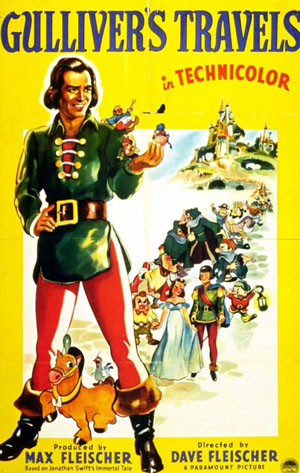 Gulliver’s Travels (Fleischer/Paramount, 12/22/39 – Dave Fleicher, dir.) – Max’s first feature effort showed its share of brilliance – as well as its share of flaws. While Fleischer’s mechanical inventiveness would carry the day in elaborate sequences detailing the operation of tying up and transporting Gulliver, the studio had less success in tackling matters such as the forces of nature. Water had been a subject that had plagued the Fleischers on several past occasions, with results of considerably varying quality. Tidal movements of ocean along a shoreline had been called for in several prior films. In “Betty Boop’s Life Guard”, the result was deliberately “toony”, with a giant, unrealistically-animated wave sweeping every sunbather off a crowded beach in one pass, then replacing them back on shore on the next pass. “Is My Palm Read” delivered some slightly more-realistic crests of water in a cove, but with additional gags of the white tops forming into hands to pat Betty Boop on the fanny. “Hawaiian Birds” strove for more realism, as well as Technicolor, but still looks pale by comparison to even the fairly-basic rendering of surf provided by the rival Disney studios in “Hawaiian Holiday”. “Educated Fish” opens with a downright-amateurish overhead view of currents at sea, with wave movement that is totally artificial and composed in badly-chosen pale colors. So, the task of animating a realistic shipwreck for Gulliver to be cast upon the isle of Lilliput must have seemed a daunting chalenge to the studio’s artists. There is no doubt that they probably referred to as much live-action reference footage as they could get their hands on for some ideas. There is a lot of action in their resulting drawings, with wave crests and water droplets galore, as Gulliver struggles to keep control of the ship’s rigging and the weather-tattered sails in a violent storm, only to get swept overboard by a tremendous wave, and cling to a section of fallen spar in order to stay afloat, until the winds die down and the currents drift him close enough to an unfamiliar shore to allow him to find a footing, trudge up the beach, and fall asleep instantly on the sand fron exhaustion. But there is still something missing in the finished result. The angle on Gulliver on deck is distant, and from a vantage point somewhere above, instead of in more-dramatic position with Gulliver on deck, to allow us to better know the character from the outset of the film and experience what he’s experiencing. The pitching of the deck moves rather mechanically, and only in one direction (side to side) rather than in random angles as a complex, choppy sea would be likely to produce. While the action in the central portions of the storm is depicted in decently-chosen colors, the shoreline sequences of the surf (especially as later depicted in the musical number “I Hear a Dream”) choose an unrealistic shade of deep green against a sandy tan, giving the scenes an unsettling surrealism that still reminds the viewer that this has not graduated beyond the level of a mere cartoon. Even Gulliver’s trudge out of the sea, in its first shot as he rises from the ocean surface, is presented in rotoscope that appears to be running too fast, making Gulliver appear artificially-energetic rather than on the brink of exhaustion. As advanced as the sequence was compared to anything the studio had previously produced, it becomes even more visually disappointing in retrospect, when one compares it to the results of Disney’s efforts a mere season later on “Pinocchio”, featuring what undoubtedly has to be the most sophisticated water and wave action ever animated, in its Monstro the Whale sequences. And Disney’s work was not a mere case of seeing the flaws of Fleischer and deciding to go one-better – as Disney had already been perfecting water animation at least concurrently with the Fleischer production, in the ocean-controlling efforts of Mickey Mouse in “The Sorcerer’s Apprentice”. The Fleischers, of course, would not have the chance to see either Disney product in time to do something about their own sequence, and so did the best they could from the limits of their own inspiration. Not to disparage “Gulliver”, which has always been a personal favorite of mine despite its flaws, but the water sequences of the film remain something that from my first viewing seemed perhaps the low point of anything presented in the film, and in rear-view hindsight looked more like something I would have expected out of low-budget early television anime.
Gulliver’s Travels (Fleischer/Paramount, 12/22/39 – Dave Fleicher, dir.) – Max’s first feature effort showed its share of brilliance – as well as its share of flaws. While Fleischer’s mechanical inventiveness would carry the day in elaborate sequences detailing the operation of tying up and transporting Gulliver, the studio had less success in tackling matters such as the forces of nature. Water had been a subject that had plagued the Fleischers on several past occasions, with results of considerably varying quality. Tidal movements of ocean along a shoreline had been called for in several prior films. In “Betty Boop’s Life Guard”, the result was deliberately “toony”, with a giant, unrealistically-animated wave sweeping every sunbather off a crowded beach in one pass, then replacing them back on shore on the next pass. “Is My Palm Read” delivered some slightly more-realistic crests of water in a cove, but with additional gags of the white tops forming into hands to pat Betty Boop on the fanny. “Hawaiian Birds” strove for more realism, as well as Technicolor, but still looks pale by comparison to even the fairly-basic rendering of surf provided by the rival Disney studios in “Hawaiian Holiday”. “Educated Fish” opens with a downright-amateurish overhead view of currents at sea, with wave movement that is totally artificial and composed in badly-chosen pale colors. So, the task of animating a realistic shipwreck for Gulliver to be cast upon the isle of Lilliput must have seemed a daunting chalenge to the studio’s artists. There is no doubt that they probably referred to as much live-action reference footage as they could get their hands on for some ideas. There is a lot of action in their resulting drawings, with wave crests and water droplets galore, as Gulliver struggles to keep control of the ship’s rigging and the weather-tattered sails in a violent storm, only to get swept overboard by a tremendous wave, and cling to a section of fallen spar in order to stay afloat, until the winds die down and the currents drift him close enough to an unfamiliar shore to allow him to find a footing, trudge up the beach, and fall asleep instantly on the sand fron exhaustion. But there is still something missing in the finished result. The angle on Gulliver on deck is distant, and from a vantage point somewhere above, instead of in more-dramatic position with Gulliver on deck, to allow us to better know the character from the outset of the film and experience what he’s experiencing. The pitching of the deck moves rather mechanically, and only in one direction (side to side) rather than in random angles as a complex, choppy sea would be likely to produce. While the action in the central portions of the storm is depicted in decently-chosen colors, the shoreline sequences of the surf (especially as later depicted in the musical number “I Hear a Dream”) choose an unrealistic shade of deep green against a sandy tan, giving the scenes an unsettling surrealism that still reminds the viewer that this has not graduated beyond the level of a mere cartoon. Even Gulliver’s trudge out of the sea, in its first shot as he rises from the ocean surface, is presented in rotoscope that appears to be running too fast, making Gulliver appear artificially-energetic rather than on the brink of exhaustion. As advanced as the sequence was compared to anything the studio had previously produced, it becomes even more visually disappointing in retrospect, when one compares it to the results of Disney’s efforts a mere season later on “Pinocchio”, featuring what undoubtedly has to be the most sophisticated water and wave action ever animated, in its Monstro the Whale sequences. And Disney’s work was not a mere case of seeing the flaws of Fleischer and deciding to go one-better – as Disney had already been perfecting water animation at least concurrently with the Fleischer production, in the ocean-controlling efforts of Mickey Mouse in “The Sorcerer’s Apprentice”. The Fleischers, of course, would not have the chance to see either Disney product in time to do something about their own sequence, and so did the best they could from the limits of their own inspiration. Not to disparage “Gulliver”, which has always been a personal favorite of mine despite its flaws, but the water sequences of the film remain something that from my first viewing seemed perhaps the low point of anything presented in the film, and in rear-view hindsight looked more like something I would have expected out of low-budget early television anime.
 Pinocchio (Disney/RKO, 2/23/40), briefly uses stormy weather for particularly dramatic and poignant effect. At the “suggestion” of Honest John the fox and Gideon the cat, Pinocchio is sold for a small bag of gold to Stromboli the puppet master, as star performer for his puppet show. Pinocchio is the hit of the performance, and reaps Stromboli a table full of gold coins. But Stromboli is shocked to hear Pinocchio’s ramblings about having a father, and wanting to leave to tell him and be back in the morning. Not taking any chances on letting the puppet escape, Stromboli locks him in a hanging bird cage. As he slams the door of the gypsy wagon, leaving Pinocchio in darkness, Pinocchio rattles at the bars of his cage and locked door, crying for help and for his forgotten friend Jiminy Cricket. Adding to the impact of the shot, Disney briefly lights up the interior of the cart with the flash of a lightning bolt outside. An exterior view reveals a rainstorm beginning in the dark night sky, and Jiminy Cricket huddled under his black umbrella, sadly watching the departure of the puppet wagon, believing that Pinocchio is moving on to fame and fortune, and attempting to resign himself to the fact he can always claim to others that “I knew him when…” As he begins to trudge off amidst the raindrops, he pauses, however, deciding that at least he should wish Pinocchio luck, and hops to catch up with the gypsy wagon. He is reunited with Pinocchio, but can’t get the lock on the cage to open, even after shimmying inside the keyhole for a better look. The most effective use of the storm, however, follows in a heartbreaking scene that decides the course of the whole story, by preventing an immediate rescue. Geppetto has been wandering the streets of the town, in search of his little wooden son, and pauses dripping wet at a crossroads in his path. Who should pass directly in front of him on the intersecting road but Stromboli and the gypsy wagon. Just as the wagon passes and exits the frame, Geppetto calls out with a loud “Pinocchio!”. But the full word is never heard, as a loud thunderclap occurs, drowning Geppetto’s call completely out, so that Pinocchio never hears it, and is unable to call back from inside the wagon. I remember from my first viewing feeling a pang of despair at this touching and dramatic frustration to our heroes’ hopes, and was struck by the sheer simplicity of storytelling that such a random occurrence of nature could mess up three lives so completely. Well done, Walt.
Pinocchio (Disney/RKO, 2/23/40), briefly uses stormy weather for particularly dramatic and poignant effect. At the “suggestion” of Honest John the fox and Gideon the cat, Pinocchio is sold for a small bag of gold to Stromboli the puppet master, as star performer for his puppet show. Pinocchio is the hit of the performance, and reaps Stromboli a table full of gold coins. But Stromboli is shocked to hear Pinocchio’s ramblings about having a father, and wanting to leave to tell him and be back in the morning. Not taking any chances on letting the puppet escape, Stromboli locks him in a hanging bird cage. As he slams the door of the gypsy wagon, leaving Pinocchio in darkness, Pinocchio rattles at the bars of his cage and locked door, crying for help and for his forgotten friend Jiminy Cricket. Adding to the impact of the shot, Disney briefly lights up the interior of the cart with the flash of a lightning bolt outside. An exterior view reveals a rainstorm beginning in the dark night sky, and Jiminy Cricket huddled under his black umbrella, sadly watching the departure of the puppet wagon, believing that Pinocchio is moving on to fame and fortune, and attempting to resign himself to the fact he can always claim to others that “I knew him when…” As he begins to trudge off amidst the raindrops, he pauses, however, deciding that at least he should wish Pinocchio luck, and hops to catch up with the gypsy wagon. He is reunited with Pinocchio, but can’t get the lock on the cage to open, even after shimmying inside the keyhole for a better look. The most effective use of the storm, however, follows in a heartbreaking scene that decides the course of the whole story, by preventing an immediate rescue. Geppetto has been wandering the streets of the town, in search of his little wooden son, and pauses dripping wet at a crossroads in his path. Who should pass directly in front of him on the intersecting road but Stromboli and the gypsy wagon. Just as the wagon passes and exits the frame, Geppetto calls out with a loud “Pinocchio!”. But the full word is never heard, as a loud thunderclap occurs, drowning Geppetto’s call completely out, so that Pinocchio never hears it, and is unable to call back from inside the wagon. I remember from my first viewing feeling a pang of despair at this touching and dramatic frustration to our heroes’ hopes, and was struck by the sheer simplicity of storytelling that such a random occurrence of nature could mess up three lives so completely. Well done, Walt.
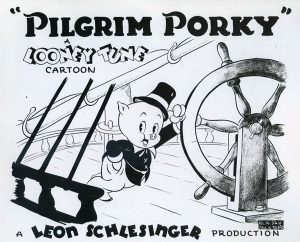 Pilgrim Porky (Warner, Porky Pig, 3/16/40 – Robert Clampett, dir.) A somewhat lackluster retelling of the voyage of the Mayflower, with Porky at the helm. As with many such retellings, there is an obligatory storm at sea. The waves grow choppy, and white caps appear – as the water is covered with an array of white golfing hats. Two lightning bolts stop in mid-air, then rub against each other to sharpen their edges like a chef’s carving knives. Taking the analogy further, one bolt remains in the shape of a knife, while the other transforms into the triple prongs of a fork, spearing a cloud to hold it steady, as the knife-bolt carves a slice off the end of the cloud like it was a roast turkey, allowing a torrent to rain to pour out like so much stuffing. A human hand holds a card in front of the camera lens, reading “The Rains Came (From the picture of the same name).” Confusing the Mayflower with the Titanic, the ship finds itself on a collision course with an iceberg. But just short of the moment of impact, the ice wall splits down the middle, with both halves pivoting to raise their center edges like a drawbridge, allowing the ship to pass. ‘Nuff said.
Pilgrim Porky (Warner, Porky Pig, 3/16/40 – Robert Clampett, dir.) A somewhat lackluster retelling of the voyage of the Mayflower, with Porky at the helm. As with many such retellings, there is an obligatory storm at sea. The waves grow choppy, and white caps appear – as the water is covered with an array of white golfing hats. Two lightning bolts stop in mid-air, then rub against each other to sharpen their edges like a chef’s carving knives. Taking the analogy further, one bolt remains in the shape of a knife, while the other transforms into the triple prongs of a fork, spearing a cloud to hold it steady, as the knife-bolt carves a slice off the end of the cloud like it was a roast turkey, allowing a torrent to rain to pour out like so much stuffing. A human hand holds a card in front of the camera lens, reading “The Rains Came (From the picture of the same name).” Confusing the Mayflower with the Titanic, the ship finds itself on a collision course with an iceberg. But just short of the moment of impact, the ice wall splits down the middle, with both halves pivoting to raise their center edges like a drawbridge, allowing the ship to pass. ‘Nuff said.
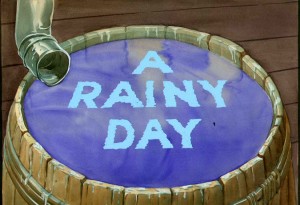 A Rainy Day (MGM, 4/20/40 – Hugh Harman, dir.) – Hugh Harman and Rudolf Ising, while each producing their own respective product for MGM during this period, seemed to be on the same wavelength when it came to bears, though each attempted to produce a series in direct rivalry to the product of the other. Ising would create the lasting persona of Barney Bear in “The Bear Who Couldn’t Sleep” (1939). Harman, on the other hand, would create one of the straightest retellings of “Goldilocks and the Three Bears” in the same year, introducing a Papa Bear whose main distinction from Barney was the wearing of a straw hat and the possession of a short temper, coupled with a scatterbrained Mama Bear who speaks and sings like Billie Burke, and a cute little baby bear (Wilbur) with oversize trousers which usually slip down to expose his “bear” butt. Harman would continue to feature his bears in two sequels – the cartoon reviewed here, and “Papa Gets the Bird”, both from 1940. Harman’s group seems to have failed to catch on with the public, and it would not be until a few years later that a rival studio would attempt to launch a three bears group as stars, in Chuck Jones’ “Bugs Bunny and the Three Bears”, producing a quartet of memorable follow-up episodes scattered into the 1950’s. As Harman’s Papa Bear used the same voice as Barney (though considerably more talkative than Ising’s own bruin), the screening of both sets of cartoons in the same television package no doubt led to confusion among the viewers as to whether they were watching Barney cartoons in a slightly different style and design, or something intended to be completely different.
A Rainy Day (MGM, 4/20/40 – Hugh Harman, dir.) – Hugh Harman and Rudolf Ising, while each producing their own respective product for MGM during this period, seemed to be on the same wavelength when it came to bears, though each attempted to produce a series in direct rivalry to the product of the other. Ising would create the lasting persona of Barney Bear in “The Bear Who Couldn’t Sleep” (1939). Harman, on the other hand, would create one of the straightest retellings of “Goldilocks and the Three Bears” in the same year, introducing a Papa Bear whose main distinction from Barney was the wearing of a straw hat and the possession of a short temper, coupled with a scatterbrained Mama Bear who speaks and sings like Billie Burke, and a cute little baby bear (Wilbur) with oversize trousers which usually slip down to expose his “bear” butt. Harman would continue to feature his bears in two sequels – the cartoon reviewed here, and “Papa Gets the Bird”, both from 1940. Harman’s group seems to have failed to catch on with the public, and it would not be until a few years later that a rival studio would attempt to launch a three bears group as stars, in Chuck Jones’ “Bugs Bunny and the Three Bears”, producing a quartet of memorable follow-up episodes scattered into the 1950’s. As Harman’s Papa Bear used the same voice as Barney (though considerably more talkative than Ising’s own bruin), the screening of both sets of cartoons in the same television package no doubt led to confusion among the viewers as to whether they were watching Barney cartoons in a slightly different style and design, or something intended to be completely different.
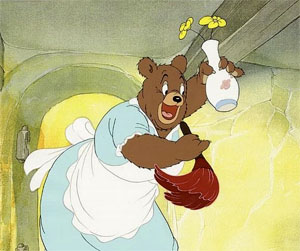 A typical morning finds Mama Bear puttering around the house dusting and cleaning, endlessly singing to herself a “Tra La La” song that everyone in the audience probably wishes she would stop immediately. She enters a back room of their cottage, and spots a stream of sunlight pouring in through a small hole in the roof, about the diameter of a dime. “Why, that man hasn’t fixed this roof yet. FATHER!” she shouts out the window. Papa is lounging in a hammock, and visibly winces when he hears Mama insist he come up to make the repair. Trying to avoid having his afternoon spoiled, Papa stalls, responding, “Aw, it ain’t gonna rain today.” As if the heavens have ears, the sound of distant thunder is heard, and dark clouds begin to gather overhead. Papa grumbles audibly, but knows he is cornered. Papa appears at the doorway of the upper room, but still looks for an excuse. He claims no rain could come through a little hole like that, and to demonstrate its unimportance, plugs the opening with one of his fingers. Mama still insists the task be performed, reminding Papa of the old adage, “A stitch in time…gathers no moss.” After she leaves the room, Papa finds he has a problem – his finger remains stuck in the hole. He tugs and tugs, finally giving a big yank – and has a pile of shingles come crashing down upon him, increasing the hole to a diameter of about four feet. Papa starts taking his temper out upon objects in the room, but repeatedly walks into the room’s door, has a plank dislodge from a nail above him and conk him on the head, and kicks a can of red paint, which splatters all over him. Pop finally gets down to business, choosing to climb out onto the roof through the existing hole rather than by using a ladder, and dislodging more shingles in the process with his large rear end. Mama, downstairs, sends Wilbur on an errand to the well, to obtain a nice cold drink of water for Papa. Back on the roof, Papa seems to be doing nothing productive, making no effort to lay shingles or boards over the gaping hole, but instead tiptoeing from one part of the roof to another, lightly tapping with a hammer upon a nail here or there to tighten it down. The clouds choose this moment to open up as if someone unleashed a waterfall from the sky, a wall of water hitting Papa point blank where he stands. Mama continues her irritating singing, changing lyric to “Pitter patter, pitter patter, listen to the rain.” Pop can hear it plenty, soaking wet above in a driving deluge. He can’t even maintain his footing on the roof’s pinnacle, and slides down one side, slamming belly-first into the chimney.
A typical morning finds Mama Bear puttering around the house dusting and cleaning, endlessly singing to herself a “Tra La La” song that everyone in the audience probably wishes she would stop immediately. She enters a back room of their cottage, and spots a stream of sunlight pouring in through a small hole in the roof, about the diameter of a dime. “Why, that man hasn’t fixed this roof yet. FATHER!” she shouts out the window. Papa is lounging in a hammock, and visibly winces when he hears Mama insist he come up to make the repair. Trying to avoid having his afternoon spoiled, Papa stalls, responding, “Aw, it ain’t gonna rain today.” As if the heavens have ears, the sound of distant thunder is heard, and dark clouds begin to gather overhead. Papa grumbles audibly, but knows he is cornered. Papa appears at the doorway of the upper room, but still looks for an excuse. He claims no rain could come through a little hole like that, and to demonstrate its unimportance, plugs the opening with one of his fingers. Mama still insists the task be performed, reminding Papa of the old adage, “A stitch in time…gathers no moss.” After she leaves the room, Papa finds he has a problem – his finger remains stuck in the hole. He tugs and tugs, finally giving a big yank – and has a pile of shingles come crashing down upon him, increasing the hole to a diameter of about four feet. Papa starts taking his temper out upon objects in the room, but repeatedly walks into the room’s door, has a plank dislodge from a nail above him and conk him on the head, and kicks a can of red paint, which splatters all over him. Pop finally gets down to business, choosing to climb out onto the roof through the existing hole rather than by using a ladder, and dislodging more shingles in the process with his large rear end. Mama, downstairs, sends Wilbur on an errand to the well, to obtain a nice cold drink of water for Papa. Back on the roof, Papa seems to be doing nothing productive, making no effort to lay shingles or boards over the gaping hole, but instead tiptoeing from one part of the roof to another, lightly tapping with a hammer upon a nail here or there to tighten it down. The clouds choose this moment to open up as if someone unleashed a waterfall from the sky, a wall of water hitting Papa point blank where he stands. Mama continues her irritating singing, changing lyric to “Pitter patter, pitter patter, listen to the rain.” Pop can hear it plenty, soaking wet above in a driving deluge. He can’t even maintain his footing on the roof’s pinnacle, and slides down one side, slamming belly-first into the chimney.
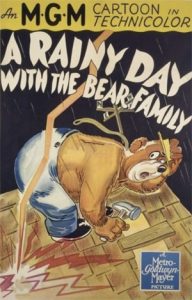 He repeats Mama’s lyric like he was uttering the worst of swear words, socking a hole in his own straw hat out of frustration. Now the clouds really go to work, producing long bolts of lightning that appear to pack a balled-up fist of energy on their forward end. The bolts deliver blows like a champion prize fighter, barely missing a fleeing Papa, who climbs once more to the top of the roof, while the lightning socks a row of huge holes into the roof shingles behind him. Papa climbs a second chimney of bricks at the height of the roof top, while the lightning blasts away section after section of the brickwork below him, ultimately shattering the chimney altogether. A bolt then makes a direct hit on Papa’s rear, lighting him up with a yellow glow like a light bulb. After a few moments, the glow subsides, but Papa’s insides still rumble with the sounds of internal thunder. He is standing next to a roof lightning rod, and is “shocked” to find his arm lighting up with the stored-up energy every time he leans close to the rod. What follows next is the most famous scene of the film, as the wind tears the entire surface of red shingles on one side of the house from its mooring in the roof beams, and transforms the shingles into a virtual “red sea” of tidal wave proportions, Papa swimming against the current as wave after wave of shinges pound down upon him. Papa is finally swept over the pinnacle of the roof, crashing down on the opposite side through the roof of the master bedroom. Papa finds himself resting on the bed, submerged four feet deep in the water-filled room. With all this floor area of the cottage’s upper story now exposed to the elements, Mama remains inexplicably bone dry in her kitchen below, as Wilbur enters the cottage, having been engaged all this time in retrieving a bucket from the well. He races up to the door of the bedroom, and hollers, “Here’s your water, Papa.” With all the water he can handle floating around him, this is all that Papa can take. Refusing to open the door, he yanks down to his level a pillow floating on the water’s surface above, pulls the blankets up over him, and settles down grumbling to a watery nap right where he is, as the scene irises out.
He repeats Mama’s lyric like he was uttering the worst of swear words, socking a hole in his own straw hat out of frustration. Now the clouds really go to work, producing long bolts of lightning that appear to pack a balled-up fist of energy on their forward end. The bolts deliver blows like a champion prize fighter, barely missing a fleeing Papa, who climbs once more to the top of the roof, while the lightning socks a row of huge holes into the roof shingles behind him. Papa climbs a second chimney of bricks at the height of the roof top, while the lightning blasts away section after section of the brickwork below him, ultimately shattering the chimney altogether. A bolt then makes a direct hit on Papa’s rear, lighting him up with a yellow glow like a light bulb. After a few moments, the glow subsides, but Papa’s insides still rumble with the sounds of internal thunder. He is standing next to a roof lightning rod, and is “shocked” to find his arm lighting up with the stored-up energy every time he leans close to the rod. What follows next is the most famous scene of the film, as the wind tears the entire surface of red shingles on one side of the house from its mooring in the roof beams, and transforms the shingles into a virtual “red sea” of tidal wave proportions, Papa swimming against the current as wave after wave of shinges pound down upon him. Papa is finally swept over the pinnacle of the roof, crashing down on the opposite side through the roof of the master bedroom. Papa finds himself resting on the bed, submerged four feet deep in the water-filled room. With all this floor area of the cottage’s upper story now exposed to the elements, Mama remains inexplicably bone dry in her kitchen below, as Wilbur enters the cottage, having been engaged all this time in retrieving a bucket from the well. He races up to the door of the bedroom, and hollers, “Here’s your water, Papa.” With all the water he can handle floating around him, this is all that Papa can take. Refusing to open the door, he yanks down to his level a pillow floating on the water’s surface above, pulls the blankets up over him, and settles down grumbling to a watery nap right where he is, as the scene irises out.
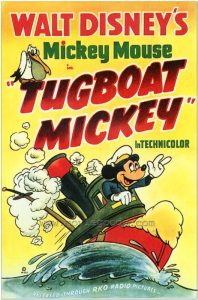 Tugboat Mickey (Disney/RKO, Mickey Mouse, 4/26/40 – Clyde Geronimi, dir.) – Though there would be three “all-star” affairs to follow including the extended Disney cast of Horace Horsecollar, Clarabelle Cow, and Clara Cluck, this film would mark the final installment in the classic Mickey, Donald and Goofy “trio” occupational films of the golden era. Animation design is sophisticated and about as far-advanced as the star characters would get in their careers, and the premise is pure fun. Visually, no storm is depicted – yet it still plays the central impetus for the plot. Tugboat captain Mickey Mouse hears a frantic call for help coming in over the radio inside the bridge of his ship, announcing that the steamship Gigantic is foundering in a storm, and can’t hold out much longer. “Oh my gosh!” shouts Mickey, and frantically rings a bell to summon his crew from below decks. Out from a hatch pop seamen Donald and Goofy, whom Mickey orders to “Get going” to power up the ship to set course for a rescue. The two seafarers scramble below, colliding with each other along the way, finally separating to perform their respective tasks. Donald runs to ready the turbine steam engine that powers the ship, inspecting it in the process. He discovers a loose nut on the drive shaft connection to the main gear powering the propeller screw, which falls off, allowing the engine’s shaft to come loose and retract into the engine mounting. Donald struggles to pull the shaft out for reconnection with the gear, but remnants of steam inside the engine hiss at him, taunt him in laughing fashion, and respond to him conversationally. Donald: “So?” Engine: “So what?” Meanwhile, Goofy takes up shovel in the boiler room, attempting to stoke the boiler with fuel from a coal hopper. A stubborn furnace door, however, refuses to stay open long enough for him to toss coal inside, resulting in the coal ricocheting off the door into Goofy’s face, or being batted back at Goofy by the door as if they were playing baseball. One impact leaves Goofy’s face implanted in his coal scuttle, which becomes bent into a silhouette matching his face.
Tugboat Mickey (Disney/RKO, Mickey Mouse, 4/26/40 – Clyde Geronimi, dir.) – Though there would be three “all-star” affairs to follow including the extended Disney cast of Horace Horsecollar, Clarabelle Cow, and Clara Cluck, this film would mark the final installment in the classic Mickey, Donald and Goofy “trio” occupational films of the golden era. Animation design is sophisticated and about as far-advanced as the star characters would get in their careers, and the premise is pure fun. Visually, no storm is depicted – yet it still plays the central impetus for the plot. Tugboat captain Mickey Mouse hears a frantic call for help coming in over the radio inside the bridge of his ship, announcing that the steamship Gigantic is foundering in a storm, and can’t hold out much longer. “Oh my gosh!” shouts Mickey, and frantically rings a bell to summon his crew from below decks. Out from a hatch pop seamen Donald and Goofy, whom Mickey orders to “Get going” to power up the ship to set course for a rescue. The two seafarers scramble below, colliding with each other along the way, finally separating to perform their respective tasks. Donald runs to ready the turbine steam engine that powers the ship, inspecting it in the process. He discovers a loose nut on the drive shaft connection to the main gear powering the propeller screw, which falls off, allowing the engine’s shaft to come loose and retract into the engine mounting. Donald struggles to pull the shaft out for reconnection with the gear, but remnants of steam inside the engine hiss at him, taunt him in laughing fashion, and respond to him conversationally. Donald: “So?” Engine: “So what?” Meanwhile, Goofy takes up shovel in the boiler room, attempting to stoke the boiler with fuel from a coal hopper. A stubborn furnace door, however, refuses to stay open long enough for him to toss coal inside, resulting in the coal ricocheting off the door into Goofy’s face, or being batted back at Goofy by the door as if they were playing baseball. One impact leaves Goofy’s face implanted in his coal scuttle, which becomes bent into a silhouette matching his face.
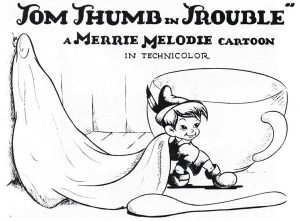 Tom Thumb in Trouble (Warner, Merrie Melodies, 6/8/40 – Charles M. (Chuck) Jones, dir.) – An extra-long, and probably ultra-expensive, Warner short, that plays as close as any Warner project ever got to being a miniature Disney feature. Jones’ artistic abilities are displayed excellently in the detailed animation of Tom’s father, a black-haired, heavily-bearded woodsman-type, who is exceptionally gentle and fond of his miniature son. Call him, if you will, what Geppetto might have been in his youth, had he had more muscles and about 80 more pounds on his person. (The comparison seems less than accidental, as there are parallels in the acting between the two films that suggest that certain scenes were directly inspired by the Disney classic released for viewing a few months before.) For convincing dramatic read, Jones chooses the same voice previously heard as Uncle Sam in “Old Glory” to serve as the father, lending a realism to the portrayal that could never have been effectively conveyed by Blanc.
Tom Thumb in Trouble (Warner, Merrie Melodies, 6/8/40 – Charles M. (Chuck) Jones, dir.) – An extra-long, and probably ultra-expensive, Warner short, that plays as close as any Warner project ever got to being a miniature Disney feature. Jones’ artistic abilities are displayed excellently in the detailed animation of Tom’s father, a black-haired, heavily-bearded woodsman-type, who is exceptionally gentle and fond of his miniature son. Call him, if you will, what Geppetto might have been in his youth, had he had more muscles and about 80 more pounds on his person. (The comparison seems less than accidental, as there are parallels in the acting between the two films that suggest that certain scenes were directly inspired by the Disney classic released for viewing a few months before.) For convincing dramatic read, Jones chooses the same voice previously heard as Uncle Sam in “Old Glory” to serve as the father, lending a realism to the portrayal that could never have been effectively conveyed by Blanc.
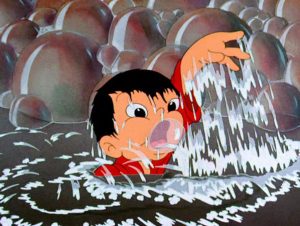 The story begins in a log cabin in the woods, where the husky father and the miniscule Tom sleep side-by-side in the same bed, Tom’s person barely covering a fraction of the full-sized pillow on which he rests. An alarm clock rings, and Tom (whose face is a bit like Pinocchio’s, but using more-slanted eye designs incorporated from Jones’ previous interpretation of the “Canyon Kiddies” comic design in “Mighty Hunters”) rises, struggling with the alarm clapper in attempt to shut off the clock’s ringing. Father awakens, helping him to stop the clock, and bids his son good morning. With realistic five-fingered hands, Father cups from a pail of water a handful of H2O as a bathing pool for Tom, into which Tom dives from a diving board supplied by his Father’s thumb, followed by drying himself on his Father’s shirtsleeve cuff. The two share a breakfast and a cup of a hearty, steaming brew (which Tom consumes from a cup made of a thimble), then Father announces he must go out to perform his work in the woods. He asks his son to do up the dishes from last night while he is away. Tom performs the task of cleaning up giant plates, glasses, and cups with a song (speaking in the same voice as Sniffles the Mouse, who would later perform the same tune with different lyrics in “The Brave Little Bat”), in a sequence which comes as close to “Whistle While You Work” as the studio dared get without a lawsuit. A small yellow bird watches from outside a window, chirping along merrily with the tune (another “Snow White”-style touch). As Tom catapults the last mug up onto a hook on an upper rack, he fails to notice a small piece of soap he has left behind in his washing, and slips on it, sliding to the end of and off the kitchen table. He plunges into a face-washing bowl that is half-filled with soapy water, and is unable to climb up the steep and slippery sides of the vessel, finding himself stranded in the soapy fluid and struggling to stay afloat. The bird outside hears his calls for help, and performs what would classify as a Herculean feat for a small bird, backing up into the skies, then zooming forward like a comet to break through the window glass. Outside, Father hears the shatter of the glass, and advances, first slowly, and then in a panicked run toward the cabin to investigate the trouble. When he opens the door, he dramatically misinterprets what he sees. The bird has fished Tom out of the water, and laid him on the kitchen table, fanning his unconscious form with his wings. Father, seeing the broken window, and the bird standing over his prone son, develops a scowl of murderous anger over his face, assuming that the bird has entered to attack his son. He swats repeatedly at the bird, aiming his mighty hand with intent to crush, and the bird barely escapes through the same window from which he entered. Tom revives, but is weak, and can’t get the breath to explain to Father what the bird really did for him. Father sets Tom back upon the pillow and under the covers on the bed, and tells him to rest and try to forget what has happened.
The story begins in a log cabin in the woods, where the husky father and the miniscule Tom sleep side-by-side in the same bed, Tom’s person barely covering a fraction of the full-sized pillow on which he rests. An alarm clock rings, and Tom (whose face is a bit like Pinocchio’s, but using more-slanted eye designs incorporated from Jones’ previous interpretation of the “Canyon Kiddies” comic design in “Mighty Hunters”) rises, struggling with the alarm clapper in attempt to shut off the clock’s ringing. Father awakens, helping him to stop the clock, and bids his son good morning. With realistic five-fingered hands, Father cups from a pail of water a handful of H2O as a bathing pool for Tom, into which Tom dives from a diving board supplied by his Father’s thumb, followed by drying himself on his Father’s shirtsleeve cuff. The two share a breakfast and a cup of a hearty, steaming brew (which Tom consumes from a cup made of a thimble), then Father announces he must go out to perform his work in the woods. He asks his son to do up the dishes from last night while he is away. Tom performs the task of cleaning up giant plates, glasses, and cups with a song (speaking in the same voice as Sniffles the Mouse, who would later perform the same tune with different lyrics in “The Brave Little Bat”), in a sequence which comes as close to “Whistle While You Work” as the studio dared get without a lawsuit. A small yellow bird watches from outside a window, chirping along merrily with the tune (another “Snow White”-style touch). As Tom catapults the last mug up onto a hook on an upper rack, he fails to notice a small piece of soap he has left behind in his washing, and slips on it, sliding to the end of and off the kitchen table. He plunges into a face-washing bowl that is half-filled with soapy water, and is unable to climb up the steep and slippery sides of the vessel, finding himself stranded in the soapy fluid and struggling to stay afloat. The bird outside hears his calls for help, and performs what would classify as a Herculean feat for a small bird, backing up into the skies, then zooming forward like a comet to break through the window glass. Outside, Father hears the shatter of the glass, and advances, first slowly, and then in a panicked run toward the cabin to investigate the trouble. When he opens the door, he dramatically misinterprets what he sees. The bird has fished Tom out of the water, and laid him on the kitchen table, fanning his unconscious form with his wings. Father, seeing the broken window, and the bird standing over his prone son, develops a scowl of murderous anger over his face, assuming that the bird has entered to attack his son. He swats repeatedly at the bird, aiming his mighty hand with intent to crush, and the bird barely escapes through the same window from which he entered. Tom revives, but is weak, and can’t get the breath to explain to Father what the bird really did for him. Father sets Tom back upon the pillow and under the covers on the bed, and tells him to rest and try to forget what has happened.
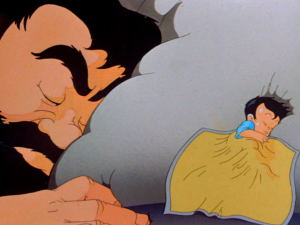 As night falls, Father again joins Tom in bed, falling asleep. Tom, however, has awakened, and has donned his full traveling clothes. He is engaged in writing a note to Father with a full-sized piece of parchment and quill pen. The note explains that the bird saved his life, and that Tom is going out to look for him. Pinning the note to his pillow, Tom ventures to the door of the cabin, somehow getting it open single-handedly, and steps out into a rising, driving snowstorm, which has already blanketed the woods in a thick covering of snow. He leaves the cabin door ajar as he exits, and after a few minutes, the door is blown shut by the rising winds, awakening Father. He spots Tom’s note, races to a window, and calls out in desperate tones the name of his son, pleading for him to come back. Jones demonstrates his skill at use of shadows and modeling in this sequence, shading every feature of Father’s face to produce maximum dramatic effect, delivering much of the pathos of Geppetto’s hopeless cries for Pinocchio in the Disney classic. The whistling winds and passing snow flurries further enhance this high point in dramatic action, while the camera follows a tiny trail of footprints over the drifts of snow, deep into the forest, where Tom wanders aimlessly in search of his friend. The distant shouts of Father fortunately awaken a pair of eyes inside the hollow recesses of a hole in the upper trunk of a tree. It is the little bird, who looks down to spot the struggling Tom. Again, the bird becomes the hero, swooping down to scoop Tom up onto his back, then battling the wintery wind back in the direction of the cabin, to return Tom home. In a scene that is obviously inspired from the deathbed weeping of Geppetto over Pinocchio, Father weeps bitterly at the kitchen table over the unknown fate of his son, moaning, “Why did you do it? Where have you gone?”. Suddenly, he looks up, and his expression changes to one of pure joy, as Tom and the bird stand at the other end of the table, Tom uttering a cheery “Hi, Pop.” Father sheds a single additional tear down his cheek, but smiles contentedly in relief. The final shot finds Tom and Dad asleep again in bed, but with one difference from the opening scenes – a third member has joined them, as the little bird now rests happily, in the nest-like comfort of Father’s beard.
As night falls, Father again joins Tom in bed, falling asleep. Tom, however, has awakened, and has donned his full traveling clothes. He is engaged in writing a note to Father with a full-sized piece of parchment and quill pen. The note explains that the bird saved his life, and that Tom is going out to look for him. Pinning the note to his pillow, Tom ventures to the door of the cabin, somehow getting it open single-handedly, and steps out into a rising, driving snowstorm, which has already blanketed the woods in a thick covering of snow. He leaves the cabin door ajar as he exits, and after a few minutes, the door is blown shut by the rising winds, awakening Father. He spots Tom’s note, races to a window, and calls out in desperate tones the name of his son, pleading for him to come back. Jones demonstrates his skill at use of shadows and modeling in this sequence, shading every feature of Father’s face to produce maximum dramatic effect, delivering much of the pathos of Geppetto’s hopeless cries for Pinocchio in the Disney classic. The whistling winds and passing snow flurries further enhance this high point in dramatic action, while the camera follows a tiny trail of footprints over the drifts of snow, deep into the forest, where Tom wanders aimlessly in search of his friend. The distant shouts of Father fortunately awaken a pair of eyes inside the hollow recesses of a hole in the upper trunk of a tree. It is the little bird, who looks down to spot the struggling Tom. Again, the bird becomes the hero, swooping down to scoop Tom up onto his back, then battling the wintery wind back in the direction of the cabin, to return Tom home. In a scene that is obviously inspired from the deathbed weeping of Geppetto over Pinocchio, Father weeps bitterly at the kitchen table over the unknown fate of his son, moaning, “Why did you do it? Where have you gone?”. Suddenly, he looks up, and his expression changes to one of pure joy, as Tom and the bird stand at the other end of the table, Tom uttering a cheery “Hi, Pop.” Father sheds a single additional tear down his cheek, but smiles contentedly in relief. The final shot finds Tom and Dad asleep again in bed, but with one difference from the opening scenes – a third member has joined them, as the little bird now rests happily, in the nest-like comfort of Father’s beard.
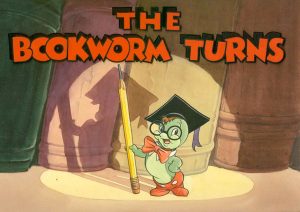 The Bookworm Turns (MGM, 7/20/40, Hugh Harman/Friz Freleng(?), dir.) – There is some question raised as to Freleng’s involvement on this project. It is definitely a sequel to his work on the original “The Bookworm”, and for all intents and purposes seems to match his style, excepting some slight redesigning of the title character to provide him with arms and stubby legs. IMDB credits Freleng, but one blogger to the site insists that Freleng was already long gone when the film went into production. Perhaps in fact its release was delayed, such that Freleng’s influence was still contributory. Anyone knowing the situation for certain regarding this point is invited to contribute their information.
The Bookworm Turns (MGM, 7/20/40, Hugh Harman/Friz Freleng(?), dir.) – There is some question raised as to Freleng’s involvement on this project. It is definitely a sequel to his work on the original “The Bookworm”, and for all intents and purposes seems to match his style, excepting some slight redesigning of the title character to provide him with arms and stubby legs. IMDB credits Freleng, but one blogger to the site insists that Freleng was already long gone when the film went into production. Perhaps in fact its release was delayed, such that Freleng’s influence was still contributory. Anyone knowing the situation for certain regarding this point is invited to contribute their information.
The film merits honorable mention due to slight involvement of a rainstorm as a starting motivation to the story. Edgar Alen Poe’s “The Raven” stares from the cover of his book out the window of the bookstore, at a bleak, darkened sky and rain-soaked window, and gets that feeling that many a child and some adults do when looking at a rain that it seems will never end – “Gee, dese dismal days give me da willies.” Stepping off his book cover, the Raven comments that he feels like he is on the verge of a nervous breakdown. Walking past an open magazine, he spots an advertisement for pills from a Dr. Quack, asking the pointed question, “Are you Dopey? Do you have that empty-headed feeling?” Turning briefly white, the Raven convinces himself that this is exactly his problem, and that he needs to see a doctor. The only one available in the immediate vicinity is a certain Dr. Jekyll, who spends much of his time randomly transforming from mild-mannered, educated physician into a lumbering, fang-toothed ape, every time he hiccups.
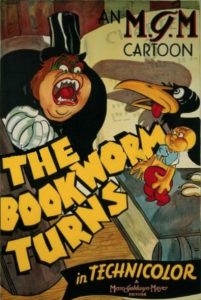 Observing these sudden transformations at the doctor’s door, the Raven is even more convinced he needs medical help – as now he is seeing things. After a brief examination (including rattling the bird’s head, only to hear the sound of loose marbles bouncing around), Jekyll diagnoses that the bird has no brain. Pointing to a diagram of his own design on the wall Jekyll informs the Raven that he can provide his patient with a brain, via a brain transfer machine. He also informs the bird that the Bookworm possesses exactly the kind of brain needed for the operation. The Raven. having dealt with this little squirt once before, declares that it’ll be a cinch to capture him, and sets out to deliver one worm to the doctor’s lab.
Observing these sudden transformations at the doctor’s door, the Raven is even more convinced he needs medical help – as now he is seeing things. After a brief examination (including rattling the bird’s head, only to hear the sound of loose marbles bouncing around), Jekyll diagnoses that the bird has no brain. Pointing to a diagram of his own design on the wall Jekyll informs the Raven that he can provide his patient with a brain, via a brain transfer machine. He also informs the bird that the Bookworm possesses exactly the kind of brain needed for the operation. The Raven. having dealt with this little squirt once before, declares that it’ll be a cinch to capture him, and sets out to deliver one worm to the doctor’s lab.
The educated Bookworm is bored with mathematics, science, and literature, complaining that nothing ever happens exciting. A pair of wings covering his eyes, and a voice asking “Guess who?” (no, it’s not Woody Woodpecker) provide more excitement than desired, as the Raven begins a merry chase of the worm, finally cornering him atop a rotating globe. “Where’s the fire?”, the Raven taunts, as the worm attempts to remain astride the rapidly-spinning sphere. “It’s a small world after all”, quips the Raven, flicking the worm off the globe surface, and catching him inside a hollow ceramic skull book end. The Raven returns to Jekyll’s lab with his captured victim, and the worm is strapped into a laboratory chair, next to which the Raven is also seated. Metal caps are placed on their heads, and Jekyll (or is it Hyde) pulls a large switch, sending electrical bolts pulsing through wires and from one cap to another, When the switch is shut off, Jekyll asks the Raven how he feels, The bird responds “My polysyllablical elocution precludes the communication of the profundities of my lucubration…Moron.” All the bookworm can say is “Gee, I got the dopiest feelin’ in my head.” While the Raven wanders to a scientific volume to double-check the theory of Professor Einstein, Jekyll turns to Hyde again, and decides to have some fun, by pulling a second switch, transforming the now-dimwitted worm into a giant.
Taking advantage of his new brute strength, the worm now pursues the Raven, with intent to likely do him some bodily harm. Hyde hiccups, reverting to Jekyll, and, seeing that he has caused some potentially-harmful mischief while acting as the monster, decides to reverse it, by pulling one of those “granddaddy of all switches” one finds in cartoons. A powerful bolt of energy transforms into the shape of a glowing hand, pulling both Raven and worm into its grip through sheer electromagnetism, then deposits the two in an endless array of boiling glass tubes filled with chemicals, seemingly lifted straight out of Harman’s earlier film, “Bottles”. After enduring wild contortions, compression devices, and a receptacle that resembles a giant coffee percolator, the two are dumped out in front of a copy of McGoofy’s First Reader, back to their old selves. “I guess there ain’t no royal road to learnin’, indubitably”, admits the Raven. He thus embarks upon private tutoring at the instruction of the worm, but lessons don’t go well, as he can spell “C-A-T”, but has absolutely no idea what it means. “Dog? Cow?” “No no, you’ll never learn”, responds the worm. “Aw, fudge. Who wants a brain anyway?”, scowls the Raven, for the iris out.
More weather fun, reaching into ‘41, next week.


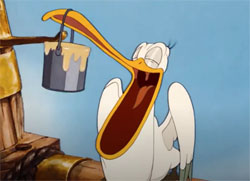
 Charles Gardner is an animation enthusiast who toils by day as a member of LA Law – but by nights and weekends indulges in classic jazz and ragtime as a performer; and studies classic Hollywood cartoons… maybe a little too much.
Charles Gardner is an animation enthusiast who toils by day as a member of LA Law – but by nights and weekends indulges in classic jazz and ragtime as a performer; and studies classic Hollywood cartoons… maybe a little too much.


































































































































































At first I thought you were a little harsh in your evaluation of the opening scene in “Gulliver’s Travels”, but after watching it again I see your point. I imagine the animation of the ocean waves must have looked even worse, if anything, on the big screen. However, I don’t think it represents the low point in the film. The low point in the film is something else entirely — and his name is Gabby.
“Tom Thumb in Trouble” isn’t the only one of this week’s cartoons to have taken inspiration from Disney’s early features. When Pilgrim Porky’s Mayflower pulls out of Plymouth Harbour, the narrator intones: “Heave ho! Heave ho! It’s off to sea we go!”
I noticed that the steam turbine in “Tugboat Mickey” hissed the words “Says you!” to Donald — a line that Donald uttered in “Clock Cleaners” and was later censored after somebody misheard it as an obscenity and complained to Disney about it.
I know this doesn’t prove anything, but the Jekyll/Hyde character in “The Bookwork Turns” reminded me that Friz Freleng directed three cartoons on the Jekyll and Hyde theme for Warner Bros.: “Dr. Jerkyl’s Hide”, “Hyde and Hare”, and “Hyde and Go Tweet”.
I enjoyed “A Rainy Day” a lot more than I expected to. That’s some brilliantly executed physical comedy, and my favourite of the week.
Interesting that you compare the animation of the waves in “Gulliver’s” to anime as I think it’s fairly obvious that the paintings of Hokusai were a major influence on that sequence.
I’m not Harman’s biggest fan, but I’m with Paul Groh, I have to admire the lush production values in this and his other shorts. And in a time when most cartoon producers couldn’t resist caricaturing W.C. Fields, let’s give Harman credit for taking a different tack and presenting Papa Bear as a caricature of Wallace Beery instead (admittedly more obvious in the earlier “Goldilocks” short than in this one).
Just now noticed that picture of Papa Bear on the wall in the first shot of
A RAINY DAY.Hilarious. But it’s Bill Littlejohn’s animation of the shingles that steals the show.“Hollywood Sweepstakes” (Columbia/Mintz, Color Rhapsodies, 28/7/39 — Ben Harrison, dir.) is a very strange cartoon, and not a very good one, but there’s quite a lot of rainfall in it.
The narrator introduces us to Hollywood’s “Santa Anteater” racetrack, where the odds-on favourite, Lightning, is going through his paces accompanied by a dwarf pony from the same stable. Lightning fastidiously avoids a large mud puddle, while the pony plows right through it. On his way back, however, Lightning falls into the puddle and immediately catches his death of cold, now much too sick to run the race. So the pony takes it upon himself to take Lightning’s place. (This is, of course, illegal and would not only invalidate the results of the race but incur lengthy jail sentences for everyone involved. But it’s a cartoon!)
The narrator praises the lovely weather: “What a day! What a glorious California day! Not a cloud in the sky to mar this beautiful spectacle! Sunny California in all its glory!” Just then, predictably, an anthropomorphic thundercloud comes along, emits a couple of lightning bolts, and disgorges a heavy downpour, turning the race track into a muddy mess. The pony is slow out of the gate, but an opportune lightning strike gives him an extra burst of speed, and a couple more propel him ahead of the pack. In an underwater shot, the pony finds a Detour sign, which he mounts on a bend in the track. The other horses see it and veer off into the distance, while the pony, now without competition, takes a leisurely pace, blithely doing the backstroke as the parrot jockey sings Venetian gondolier songs.
The other horses proceed through the floodwaters all the way to a tropical island, where the local monkeys are betting all their coconuts on “Lightning”. Now aware of what’s at stake, the horses turn around and head back to the racetrack, where the pony is still slowly backstroking away. The pace quickens as the horses approach the finish line; but then a bolt of lightning assumes the form of a policeman and holds up a STOP sign to allow a family of ducks to cross. Changing STOP to GO, the lightning policeman grabs the tape and runs with it. But the pony’s jockey takes a long stick and spins it like a helicopter rotor, allowing them to fly across the finish line to victory. When asked to say a few words to the radio audience, the pony just lets out a horse laugh.
I have to hand it to Joe De Nat. He managed to score a cartoon set during a rainstorm at a horserace without one resorting to those musical clichés “William Tell” and “Light Cavalry”.
Do you know which animated feature the 1990s Disney animators admired most, as I had it from several horses’ mouths? “Gulliver’s Travels,” which they compared favorably with what they were working on at the time. (This was post-“Lion King,” mind you.) To me its worst embarrassment is the first close-up of Princess Glory, singing “I’m always faithful, my love” while apparently suffering from Bell’s palsy the way her facial features are swimming around.
The most fascinating story point of “Pinocchio” is that none of the villains gets punished. Disney seemed to want to make the point that there’s nothing worse than a disobedient boy; but his Pinocchio isn’t really willfully disobedient (unlike the little stinker he is in the book), just naive and gullible, understandably for someone who could be said literally to have been born yesterday. Geppetto is something of a wooden head himself to send his little puppet off to school alone. What’s Teach going to say?
The underrated “Tom Thumb in Trouble” is a remarkable cartoon in its presentation of a human male character (typed in cartoons of the time either as a boy, a clown, a villain, a grandpa, or a faintly effeminate Prince Charming) who was manly yet gentle, even capable of shedding a tear. A feat Disney wouldn’t achieve until… have they even done it yet? Fleischer handled testosterone better, as evidenced by Popeye and Bluto, even Gulliver (although he says “Well” petulantly once or twice).
Most of the MGM cartoons circa 1940 are little more than overdone.
I must confess I’d forgotten to mention the persona-less Prince and Princess as among the worst embarrassments of “Gulliver’s Travels” -but perhaps this is not surprising, as they were, literally, so forgettable. Despite their song being a central plot point to the rewrite, they are nearly the last thing one thinks of in remembering the film. (Better not get me started too deeply into analyzing other flaws in the film, as I might fill a volume – though I might equally discourse on the film’s good points.) But I think it fair to mention that even Disney didn’t have much luck instilling meaningful personality in Snow White’s Prince Charming – and was still having trouble with such characters at least as late as “Sleeping Beauty”, which tried hard but still couldn’t allow you to pick Prince Phillip out of a pack of princes. But let’s not forget that the award for the most embarrassing portrayal of secondary royalty in animation would have to belong to Walter Lantz and Burt Gillett, in 1939’s “The Sleeping Princess”. where a wave of the fairy’s wand transforms a prince who is a goony buffoon into a stuffed shirt who is drawn in ugly, awkward poses, is so stiff he can barely move, and performs the most unwatchable awakening kiss of a Princess ever conceived. Atrocious!
You got to give the Disney animators an A for effort for at least trying to give Phillp more personality than the previous Disney princes. I’m sure they would’ve gotten even closer had Walt not been juggling over a dozen projects at the time of film’s long production schedule.